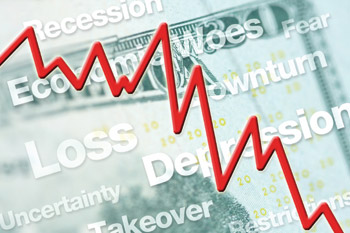Disaster looms for the banks

Banks everywhere falling like ninepins, unless governments inject huge amounts of capital into the banks we are headed for a 1930s-style ‘Great Depression’
13 September 2008
 In last month’s issue of ShelfLife I wrote that: “If the global financial system remains gridlocked then major bank failures are inevitable.” However, along with even the most pessimistic observers I was surprised by the speed with which the credit crunch, the seriousness of which national governments and central banks had consistently under-estimated since it first struck in August 2007, finally went nuclear.
In last month’s issue of ShelfLife I wrote that: “If the global financial system remains gridlocked then major bank failures are inevitable.” However, along with even the most pessimistic observers I was surprised by the speed with which the credit crunch, the seriousness of which national governments and central banks had consistently under-estimated since it first struck in August 2007, finally went nuclear.
The first act of the banking crisis was the US government’s decision to effectively nationalise mortgage giants Freddie Mac and Fannie Mae. As between them these two companies had underwritten a massive $5.3bn in US home loans, about half of the total, they were widely reckoned to be too big to fail. The rescue of Freddie and Fannie enraged the free-market zealots in the Republican Party. So when investment bank Lehman Brothers came cap in hand to Uncle Sam it was politely shown the door.
Instead on 14 September, in what now looks like a disastrous piece of free-market bravado, US Treasury Secretary Hank Paulson allowed Lehman, one of the top Wall Street investment banks, to go bust. If Paulson believed that allowing Lehman to fail would teach the markets a salutary lesson on the dangers of taking on board too much risk, he was quickly disabused.
Suddenly the fears of investors about the health of the house of cards that constitutes the international financial system crystallised. If Lehman, one of Wall Street’s “bulge bracket” investment banks, could go bust then any bank anywhere could go bust, they reasoned.
Since then investors have been dumping bank shares for whatever price they can get as fast as they can.
The headless chicken approach
The response of governments and central banks to this financial meltdown has been pitifully inadequate. Instead of co-ordinated moves to head off disaster they have been behaving like a bunch of headless chickens.
In the United States the $850bn Paulson bank bailout package was finally passed by Congress on 3 October. In Europe several governments including our own have guaranteed bank deposits while there have also been several bank rescues mounted by individual national governments or groups of national governments.
These include the shotgun marriage of UK banks Lloyds TSB and HBOS, the effective nationalisation of Fortis by the Dutch and Belgian governments, the botched rescue of Hypo Real Estate by the German government and the bail out of Dexia by the French and Belgian governments.
In this country matters finally came to a head on Monday 29 September. On “meltdown Monday” the index of Irish bank shares fell by over a quarter with the shares of one bank, Anglo Irish, collapsing by 46% and the share price of a second, Irish Life & Permanent, nose-diving by 38%.
With the Irish banking system within hours of seizing up completely the Irish government had to act. Even so its response on the morning of Tuesday 30 September was dramatic. By unconditionally guaranteeing the deposits of the Irish-owned banks, Ireland.Inc has taken on board a contingent liability of at least €477bn, the equivalent of three times our national output.
However, as the renewed falls in the value of Irish bank shares after the initial bounce that followed the announcement of the deposit guarantee make clear, the deposit guarantee doesn’t address the fundamental issue facing the Irish banks, which is that losses on property lending threaten to wipe out much if not most of their capital.
In other words, the real problem facing the Irish banks is one of solvency rather than liquidity. The liquidity crisis which came to a head on 29 September was merely a reflection of the fears which investors and other banks had about the solvency of Irish banks. No-one wants to lend money to a bank which might be about to go bust.
Over exposed and headed for crisis
Between them, the six banks now covered by the guarantee, AIB, Bank of Ireland, Anglo Irish, Irish Life & Permanent, Irish Nationwide and EBS, have total loans of about €407bn. More than three quarters of this lending, about €310bn, is secured on property. More than half of this property lending, about E165bn, has been lent to builders and property developers in Ireland and overseas.
It is this high-risk property lending which is the real concern about the Irish-owned banks. If even 10% of this lending isn’t repaid, then two-thirds of the core capital of the Irish-owned banks would disappear. A 15% write-down in lending to builders and property developers would completely wipe out the equity of the Irish-owned banks.
With their huge exposure to builders and property developers, a major crisis at one or more of the Irish banks is inevitable as loan books are written down to more realistic levels. While a number of Irish banks are probably not worth saving, such is the extent of bad property loans that even some fundamentally sound institutions may have to be rescued. When this happens it will be the taxpayer who will have to pick up at least some of the tab as the banking system is recapitalised.
Indeed the legislation passed by the government to give legal effect to the deposit guarantee seems to anticipate bank bailouts. Section six of the Credit Institutions (Financial Support) Act gives the Minister for Finance virtually unlimited power to either lend money or buy shares in any bank while section seven gives him the power to approve any bank merger or takeover he deems to be necessary to maintain the financial stability of the state, even if the transaction breaches normal competition regulations.
The game is up
The time for such bank bailouts in Ireland and other countries is now upon us. The markets have lost all confidence in the banks. And guess what, they’re right. After 15 years of irresponsible lending most banks are as good as bust.
The response of governments and central banks to this financial meltdown has been pitifully inadequate. The piecemeal, ad hoc actions we have seen so far are no substitute for a combined response. To be effective, this has to tackle the underlying problem. This is that most banks, even those which are fundamentally sound, need fresh capital and that European interest rates are still way too high.
With every day that passes the danger of a 1930-style depression increases. Once deflation (falling prices) gets a grip it can take a decade or more to lift. During that time consumers put off spending decisions in the expectation that prices will fall further, the banks go bust, businesses close, the economy grinds to a halt and unemployment soars.
With disaster looming time is short. Will the world’s governments and central banks take the sort of co-ordinated action needed to pull the global economy back from the precipice? Don’t hold your breath.



 Print
Print





Fans 0
Followers